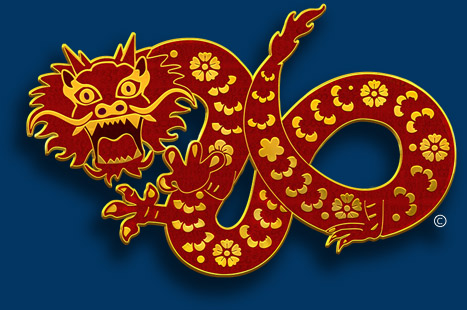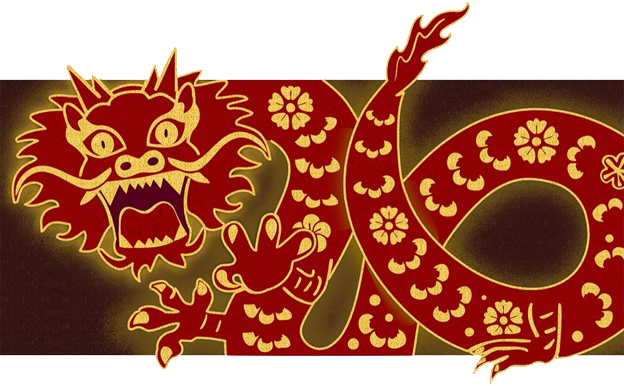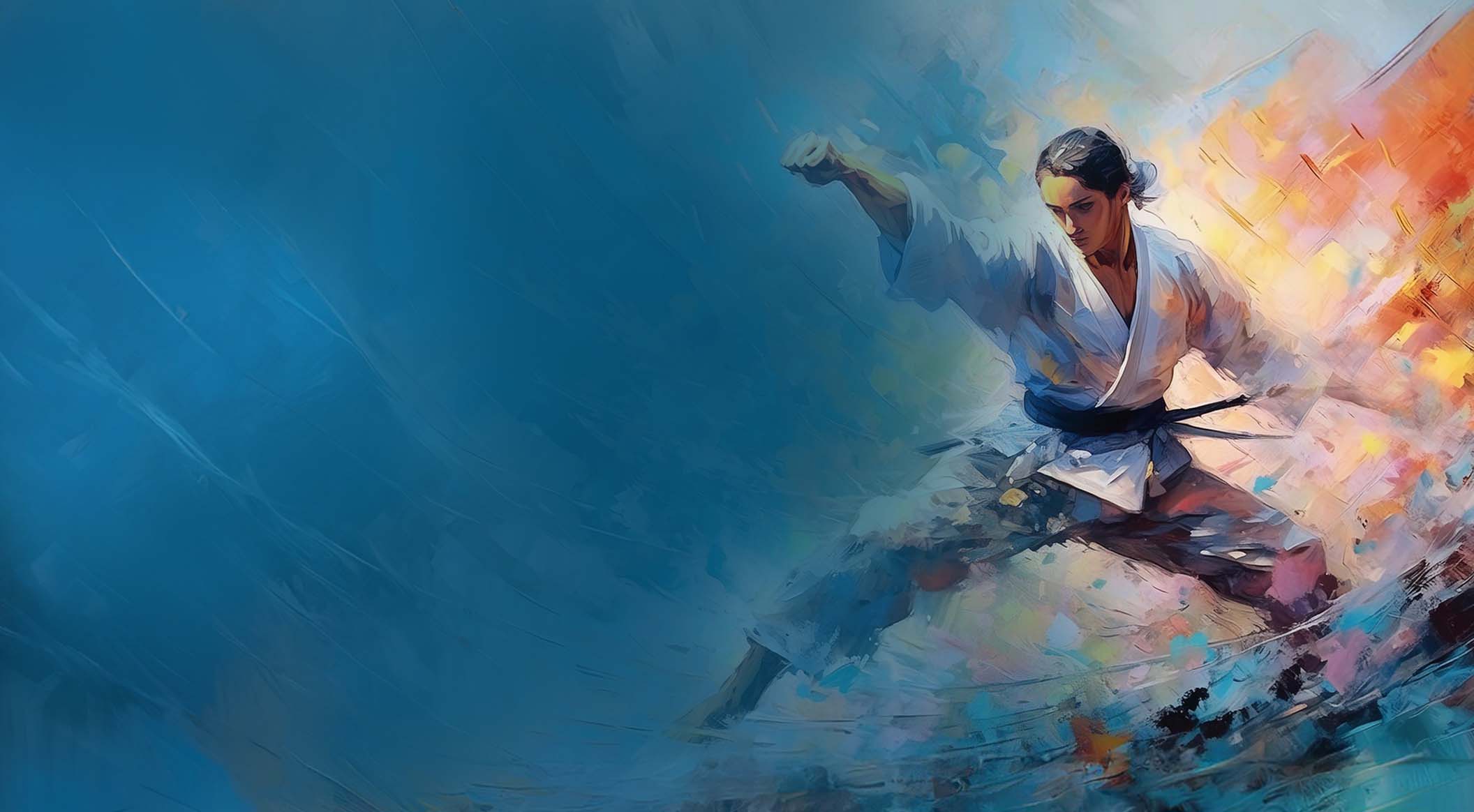How to Get Faster, Without Trying
By George Donahue
 |
George Donahue practice the first move of Pin'an one (Pin'an two or Heian two in some styles). |
The first move of some of the basic katas of the Shorin tradition, including Shotokan and its offshoots (and many basic katas of other traditions), is a trained reaction to being startled or surprised. In schools that maintain the old ways, most of the training involved is in what NOT to do.
Imagine a parent driving a car with a child (even a grown offspring) in the front passenger seat. If the average parent has to hit the brakes unexpectedly, the first thing that happens as the foot presses the brake pedal is an almost universal startle reaction: The parent throws out his or her right arm to shield the child.* The move is a combination of an effort to restrain the child from slamming forward and an attempt to cushion the child. No conscious thought is involved. It doesn't matter whether the child is firmly buckled or flagrantly unsecured, the parent's reaction is the same. Even people who are ordinarily very slow at reacting, tortoise slow in their movements, do this arm throw with great speed. It's almost instantaneous and sometimes powerful enough to leave bruises on both the parent's arm and the child's torso.
Now picture yourself doing any of the basic katas of your repertoire. I'll use Pin'an Shodan (Heian Nidan**) as an example. We often practice this kata very slowly, deliberately, and simplistically with moves broken down into their components and even subcomponents. This is the ordinary way to practice, and it serves many good purposes. Unfortunately, when we then want to practice at full power and speed, if we're not careful we stay on the same continuum as the slow-motion movement. We do the move quickly but not explosively. We perform ordinarily when we ought to be explosively extraordinary. To use old Star Trek terminology, we move from Warp Factor One (slow, deliberate motion) to Warp Factor Two (fast, deliberate motion). What we need to do is jump directly from a resting posture or normal deliberate speed to Warp Factor Five, or Ten, or more — a speed that leaves not an instant for deliberation. We need the speed of a parent protecting a child. We need the speed of a dog jumping straight up when it finds itself about to step on a snake. (Some humans do this, too. If you are one of those humans, you already know how to move at Warp Five. You just need to replicate it in your kata.)
There are several rudimentary factors involved in producing this hyper speed.
First, there is no time for a windup, either of the limb or the torso — so we skip it. Only with arrows and some guns is a cocking motion necessary. Fists and feet don't need it. In fact, in all martial arts windups are almost always unnecessary and often are counterproductive anyway, except when the intent is to deceive. The parent in the example above doesn't take a windup and yet generates great power and speed.
Second, there is no attempt to tighten the muscles into a focus position. That would be the same as slamming the brakes on the limb as you slam the brakes on the car. Your arm wouldn't get into position in time to protect your child. The relaxed, unflexed arm works much like a whip. If there is any tightening at all, it happens after the parent's arm is completely in the protective position.
Third, we don't focus our intentions or our actions on the arm being thrown out to protect the child. We do it without thought, without concentration, without focus. That way, we can perform many actions simultaneously. In the car, at the same time we'd be throwing out the protective arm, we would be pressing the brake pedal, maybe pressing the clutch pedal, if we had one, maybe violently turning the steering wheel to avoid collision and, if not, then holding the wheel firmly to keep control of the car.
Fourth, we don't imagine a specific attack that will always trigger the first move of the kata. If we get into the habit of thinking that a kata symbolizes the reaction of a defender dealing with an attacker doing exactly Attack A or Attack B, either of which is best dealt with by Reaction C or Reaction D, then we needlessly limit our repertoire, at least. At most, we train our bodies to work in only one or a few specific ways. When things don't go exactly as scripted, we have to think quickly to modify or overcome our trained specific reaction. Quick thinking is always slower than no thinking.
So, I've just set out four things we don't do if we want to succeed in the car or in the kata. The average person can easily double the speed of a reaction by avoiding these four impediments. Unfortunately, it's sometimes harder to learn to undo something than it is to learn to do something. Although there are several elements we can add to our way of moving, such as proper breathing, use of koshi, arches, compression and torque, and visualization, it's important to clear out the impediments to speed and power first.
Getting back to Pin'an Shodan, or any Pin'an kata, for that matter: Try relaxing as completely as you can while standing in the ready position, using just enough energy to remain standing. Since your arms play very little part in keeping your body erect, they can and should be as limp as wet, over-boiled noodles. At the signal to begin the kata, whip your hands from in front of you to their final position. Don't worry about being crisp or exact, don't worry about the path of your movement — your hands can't go farther than the end of your arms anyway. Don't even worry about being fast, just whip it.
After you've consistently doubled your speed, you can begin to think about refining your movements or about the many possible applications of those movements. Then, too, is a good time to begin to add advanced elements to your movements. Once again, however, it's important to get rid of what is not essential before you attempt to add new elements.
Footnotes:
* Throwing out your arm to protect your passenger doesn't really do much to secure the safety of the passenger, but we do it anyway. It's a small indication of the essential nobility of human nature.
** Gichin Funakoshi-sensei switched the order of Pin'an Shodan and Nidan when he renamed the Pin'an series to Heian, with Pin'an Shodan becoming Heian Nidan and Pin'an Nidan becoming Heian Shodan. Some Shorin schools followed his example, as far as the order of the kata and for those schools former Pin'an Shodan became Pin'an Nidan, and vice versa.
Copyright © 2011 George Donahue & FightingArts.com
All rights reserved

George Donahue
George has been on the board of FightingArts.com since its inception and is also a Contributing Editor.
George is a retired book editor, with a career spanning four decades, among his positions have been editorial stints at Random House; Tuttle Publishing, where he was the executive editor, martial arts editor, and Asian culture editor; and Lyons Press, where he was the senior acquisitions editor and where he established a martial arts publishing program. At Tuttle, he was the in-house editor for the Bruce Lee Library. Throughout his career he also edited, acquired, or reissued a wide array of military history, martial arts, and Asia-centric titles.
He was born in Japan in 1951 and originally named Fujita Tojo, with the Buddhist name KanZan. He was renamed George Donahue when he was several months old. After living part of his early childhood in the U.S. and France, he returned to Japan when he was seven years old and immediately was put (involuntarily) into intense training in traditional Japanese martial arts. His childhood training in Japan was focused on judo and jujutsu, primarily with Ando Shunnosuke, who blended keisatsujutsu (often referred to as police judo) and Olympic style judo in his teaching. He also studied kyujutsu (archery), sojutsu (spear), and kenjutsu (swordsmanship), with several teachers under the direction of his uncle, Tomita Yutaka. Following his return to the U.S. when he was twelve years old, he continued to practice judo and jujutsu, as well as marksmanship with Western style compound bow and firearms, and began the study of Matsubayashi Ryu karate in his late teens. Subsequently, he has studied aikido and cross trained in Ying Jow Pai kung fu. He began studying tai chi chuan in 1973 and now teaches qi gong and tai chi for health and fitness, as well as Okinawa Taijiken, which blends the principals of Okinawan karate with tai chi.
After studying Okinawa Karatedo Matsubayashi Ryu for ten years, he changed his focus to the teaching of Kishaba Chokei. He has been a student of Shinzato Katsuhiko, the director of Okinawa Karatedo Shorin Ryu Kishaba Juku, which comprises karate and kobujutsu (including Yamane Ryu Bojutsu) since 1983. He was also a student of Nagamine Shoshin, Nagamine Takayoshi, Kishaba Chokei, and Nakamura Seigi until their deaths. A key teacher in the U.S. was Arthur Ng, with whom he trained and taught for several years in New York City. He currently teaches Kishaba Juku privately, along with special training in karate, weapons, and self-defense. He has taught seminars throughout the U.S. and in Israel.
He has been teaching martial arts almost continually for sixty years. His first class, at twelve years old, was in judo for a group of military dependents and airmen at Sioux City Air Base, Iowa, at a time when the Air Force Strategic Air Command was beginning to stress training in martial arts, particularly jujutsu.
He was introduced to Kundalini Yoga practice in Japan but didn't begin serious practice of Kundalini and Hatha Yoga until he was in college. He practices yoga at least an hour a day and now teaches various approaches to yoga. He is also a cancer exercise specialist and a Livestrong at the YMCA instructor, helping cancer survivors regain and maintain their vitality.
Search for more articles by this author:






